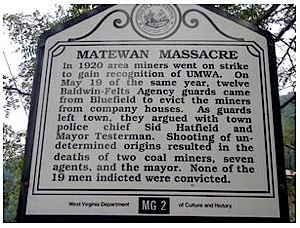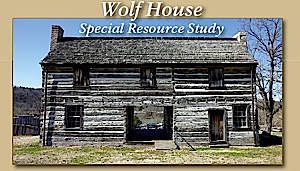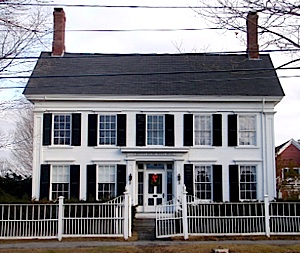Pick any one day and you can be sure the National Park Service, directed by Congress, is looking into the feasibility of adding a site, or a dozen, to the National Park System. So what sites might be coming to your neighborhood? Read on.
Congress quite routinely directs the Park Service to conduct "special resource" studies into candidates for the system. Here's a look at some of the 40 studies that were pending as of June 8. Twenty-seven involve sites for inclusion into the National Park System, six are identified as potential national heritage areas, and two are proposed to be added to the National Wild and Scenic River System.
* Battle of Matewan
This was such an incredible event in West Virginia, and the history of labor unions, that a movie was made out of it.

The site of the Matewan Massacre in West Virginia is being considered for addition to the National Park System.
Titled, simply, Matewan, this 132-minute film covered one of the darkest days in United Mine Workers history. So one-sided was the actual event, on May 19, 1920, that it became known as the "Matewan Massacre."
As history tells us, the event revolved around a union organizing effort at a coal mine in Matewan. After the miners went on strike to gain union affiliation, a dozen agents from the Baldwin-Felts Agency traveled to Matewan to remove the miners from their company-owned housing. An argument ensued, there were shots fired, and in the aftermath two coal miners were killed, along with seven Baldwin-Felts agents and the mayor of Matewan.
Public comment is being taken on this proposal, which the Park Service began studying in 2009, through July 31.
* Sainte Genevieve County, Missouri
As the name might indicate to some, Sainte Genevieve County has some French blood in its background. Indeed, it once was "part of France’s Upper Louisiana Territory, a vast area that encompassed the Mississippi and Missouri River drainage basins, and included much of what is now the middle third of the United States."
According to legislation calling for Park Service consideration of it as a new unit, "(T)he town, located along the Mississippi River in southeast Missouri, was settled in the 1700s by French colonists. The colonists came to mine lead, harvest salt from a local saline stream, and grow export crops along the Mississippi River bottomland. To this day, Ste. Genevieve contains an impressive share of the colonial French buildings remaining in North America, including three of five known remaining ‘‘poteaux-en-terre’’ houses, structures built around posts anchored in the ground. Similar structures in other old French towns were swept away by floods of the Mississippi in the 19th century."
"... The structures and locations to be studied include Bequette-Ribault, St. Gemme-Amoureaux and Wilhauk homes, as well as Le Grand Champ field, historic downtown Ste. Genevieve, and a prehistoric Native American Village." The study into the site was begun in 2009.
* Wolf House, Norfolk, Arkansas
According to the National Park Service:
The Wolf House stands on a hill overlooking the confluence of the North Fork River and the White River in present-day Norfork, Arkansas. Constructed by Territorial Arkansas trader, blacksmith, builder, and statesman Jacob Wolf, the two-story log structure is one of the last of its kind still standing west of the Mississippi, and is the oldest public building in Arkansas.
A log house dating to 1829 might be added to the National Park System. NPS photo.The date of construction of the house has been a matter of some debate over the years, but recent scholarship and scientific testing places the date of construction ca. 1829. Jacob Wolf, who also held the title of Major from his service in the Arkansas Territorial Militia, settled in the area in 1820 with members of the Wolf and Adams families. He held claim to approximately 75 acres at the river junction, which was a popular trading area with local Shawnee and Delaware Indians. Wolf secured a license to operate a ferry across both the North Fork and the White Rivers, and a town developed around the ferry and family homestead.
A draft of the resource study is expected this fall.
* Harriet Beecher Stowe House, Maine
Already a registered National Historic Landmark, this house in Brunswick, Maine, is where Ms. Stowe wrote Uncle Tom's Cabin while she lived there between 1850 and 1852.
Published as a serial in the abolitionist newspaper, National Era, in 1851 and in book form the following year, Uncle Tom's Cabin is considered to be the most famous example of antislavery literature. The book became an overnight sensation in the United States and Europe and has been translated into 23 languages.
The already a National Historic Landmark, the Harriet Beecher Stowe House is being considered for addition to the National Park System.Harriet Beecher Stowe introduced the horrors of slavery to large numbers of Americans and became the object of violent hatred throughout the South. Her reply to southern criticism came in 1853 when she published A Key to Uncle Tom's Cabin, a collection of factual material on slavery intended to justify the charges implied in the novel. The impact that Uncle Tom's Cabin had on the American public was so great that President Lincoln, upon meeting Stowe, is reported to have said, "You're the little lady who started this great war."
This proposal is somewhat on the backburner. A final report to the Interior secretary isn't scheduled until summer 2012.
* Alexander Hamilton Estate Grange, St. Croix, U.S. Virgin Islands
Alexander Hamilton, a founding father of the United States and its first secretary of state, already is "in" the National Park System, via the Alexander Hamilton Grange in New York City.
This proposal involves "Estate Grange and other sites on St. Croix that are associated with Alexander Hamilton's childhood."
The study was orderd in 2009.
* Green McAdoo School, Tennessee
This school tells a chapter of the United States' battle with segregation. It opened as the Clinton Colored School in 1935, and was renamed in 1947 to honor a Buffalo soldier who once owned the land it stands on, according to legislation requesting the study.
Further, the legislation notes:
* In 1950, the parents of 5 Clinton, Tennessee, children filed a lawsuit to gain entrance into Clinton High School. At the time, Tennessee and Anderson County law required the segregation of secondary schools. The case became known as McSwain v. Anderson County.
* The case was dismissed by the Federal District Court under the ‘separate but equal’ doctrine; the case was appealed by the parents, but suspended pending a Supreme Court ruling in Brown v. Board of Education.
* Following the Supreme Court’s decision in Brown v. Board of Education which abolished the ‘separate but equal’ doctrine, the Federal District Court in Tennessee issued an order on January 4, 1956, requiring desegregation of Anderson County schools no later than the fall term, 1956.
* On August 25, 1956, 12 students from Green McAdoo School met at the school before walking together to the all-white Clinton High School to become the first African-American students to effect the integration of a southern, state operated school.
* On September 1, 1956, Clinton, Tennessee became the first southern town to be occupied by National Guard troops in an effort to quell violence sparked by protestors from all over the United States who were opposed to school integration.
* In 1957, Bobby Cain, a former Green McAdoo student, became the first African-American to earn a diploma from an integrated school following the Brown v. Board of Education ruling.
* In 1958, the newly integrated Clinton High School was destroyed by dynamite that most assumed was placed by segregationists. The community had the students back in school in four days at an abandoned elementary school in neighboring Oak Ridge, Tennessee. Anderson County rebuilt Clinton High School and it and Green McAdoo School are the only remaining schools associated with the Clinton desegregation crisis.
* Honouliuli Gulch Internment Site, Hawaii
Approximately 120,000 Japanese Americans, most of them United States citizens, were incarcerated during World War II. The internment story has garnered increasing national attention over the past 20 years with a focus on events that took place on the West Coast and other mainland sites.
The sites of the Manzanar, Minidoka, and Tule Lake Internment Camps are now units of the National Park System. In contrast, the Hawaiian internment story has received relatively little attention.
Because the 160,000 Hawaiians of Japanese ancestry comprised almost 40 percent of the islands' population and were vital to the economy, the wholesale incarceration of Japanese Americans was neither feasible nor desirable. However, over 2,000 Japanese Americans, as well as over 100 German Americans and Italian Americans, both aliens and U.S. citizens, were interned at eight locations in Hawai'i.
Other studies under way (where available, we've linked to details):
For inclusion in National Park System
* San Gabriel Mountains and Watershed, California
*John H. Chafee Blackstone River Valley National Heritage Corridor, Masschusetts and Rhode Island
* Space Shuttle Columbia Memorial, Texas
* Newtonia Civil War Battlefields, Missouri
* Soldiers Memorial Military Museum, Missouri
* Rim of the Valley Corridor, California
* Butterfield Overland Trail, multiple states
* Walnut Canyon, Arizona
* Shepherdstown Battlefield, West Virginia
* Tule Lake Segregation Center, California
* Battle of Camden, South Carolina
* Fort San Geronimo, Puerto Rico
Potential National Heritage Areas
* Southern Campaign of the Revolution, South Carolina
* Columbia-Pacific, Oregon and Washington
* Abraham Lincoln sites, Kentucky
* Chattahoochee Trace, Alabama and Georgia
Wild and Scenic Rivers
* Lower Farmington River, Connecticut
* Missisquoi and Trout, Vermont
National Trails System
* Long Walk National Historic Trail, NPS Intermountain Region
* Lewis and Clark National Historic Trail, Eastern Legacy, NPS Midwest Region
* Chisholm Trail, Intermountain Region
* Great Western Trail, Intermountain Region
* Revise four existing feasibility studies involving the Oregon, Pony Express, California, and Mormon Pioneer trails, Intermountain Region



 Support Essential Coverage of Essential Places
Support Essential Coverage of Essential Places







Comments
Hmmmmm. Some of these sound like good state parks. But NATIONAL parks?
But even Tea Party congresscritters need to bring home the pork.
While a study is probably better than haphazard designations, Congress all too often ignores NPS recommendations. IIRC NPS considered it unnecessary or infeasible for River Raisin and Paterson Great Falls to be part of the national park system but Congress designated them anyway. On the flip side, the Harriet Tubman proposals, highly recommended for park status by NPS, are still in limbo. In addition, sites clearly lacking in national significance are ordered for study so as to bring home the bacon, as a previous poster noted. Not sure how to improve this situation though.
The Congressional delegation in Colorado is trying to get a study done for NPS inclusion of Camp Hale, near Leadville, the training ground for the 10th Mountain Division troops during WWII.
I do not know how you could have left off my personal vote for the future NP Fort Monroe ;o)
http://www.fmauthority.com/
Semper Fi
Doc